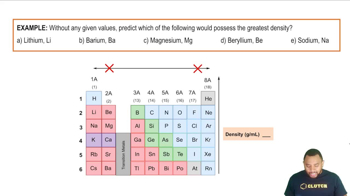For each element, predict where the 'jump' occurs for successive ionization energies. (For example, does the jump occur between the first and second ionization energies, the second and third, or the third and fourth?) a. Be b. N c. O d. Li
Ch.8 - Periodic Properties of the Elements
Chapter 8, Problem 79a
Choose the element with the more negative (more exothermic) electron affinity from each pair. a. Na or Rb
 Verified step by step guidance
Verified step by step guidance1
Understand that electron affinity refers to the energy change when an electron is added to a neutral atom in the gaseous state. A more negative electron affinity indicates a greater tendency to gain an electron.
Recall that electron affinity generally becomes more negative across a period from left to right and less negative down a group in the periodic table.
Identify the position of Na (Sodium) and Rb (Rubidium) in the periodic table. Na is in the third period, while Rb is in the fifth period.
Consider the trend: as you move down a group, the electron affinity becomes less negative due to increased atomic size and electron shielding, which makes it harder for the nucleus to attract additional electrons.
Based on the periodic trend, predict that Na, being higher up in the group than Rb, will have a more negative (more exothermic) electron affinity compared to Rb.

Verified video answer for a similar problem:
This video solution was recommended by our tutors as helpful for the problem above.
Video duration:
1mWas this helpful?
Key Concepts
Here are the essential concepts you must grasp in order to answer the question correctly.
Electron Affinity
Electron affinity is the energy change that occurs when an electron is added to a neutral atom in the gas phase. A more negative electron affinity indicates that the process is more exothermic, meaning energy is released when the atom gains an electron. This property is crucial for understanding how easily an atom can accept an electron and form an anion.
Recommended video:
Guided course

Electron Affinity
Trends in the Periodic Table
Periodic trends refer to the predictable patterns observed in the properties of elements as you move across or down the periodic table. For electron affinity, it generally increases (becomes more negative) across a period from left to right and decreases down a group. Understanding these trends helps in predicting the electron affinity of elements based on their position in the periodic table.
Recommended video:
Guided course

Periodic Trends
Group 1 Elements
Group 1 elements, also known as alkali metals, include lithium, sodium, potassium, rubidium, cesium, and francium. These elements have low ionization energies and tend to lose one electron easily, making their electron affinities less negative compared to other groups. When comparing sodium (Na) and rubidium (Rb), it is essential to consider their positions in the group and how their atomic size affects their ability to attract additional electrons.
Recommended video:
Guided course

Main Group Elements: Density Example
Related Practice
Textbook Question
Textbook Question
Consider this set of ionization energies. IE1 = 578 kJ/mol IE2 = 1820 kJ/mol IE3 = 2750 kJ/mol IE4 = 11,600 kJ/mol To which third-period element do these ionization values belong?
2
views
Textbook Question
Choose the element with the more negative (more exothermic) electron affinity from each pair. b. B or S
Textbook Question
Choose the element with the more negative (more exothermic) electron affinity from each pair. c. C or N d. Li or F
Textbook Question
Choose the element with the more negative (more exothermic) electron affinity in each pair. a. Mg or S b. K or Cs c. Si or P d. Ga or Br
